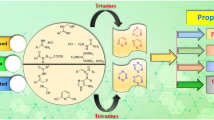Abstract
Investigation on strength of the tris(2-amino ethyl) amine and tris (3-amino propyl) amine backboned tripodal receptors, L and L1 (incorporated with tripodal C3ν frame, thio urea-amide linkage and π-hole assisting functionality) which are premeditated to explore the prospect for a particular anion recognition are studied. UV-Vis, 1H- NMR, and IR spectroscopy studies indicates that both the receptors sensing azide anion, colorimetrically and binds azide anion stronger than any other anions such as acetate, and cyanide. In particular the receptor L1 shows the highest binding strength towards azide anion. To the best of our knowledge this is the first receptor showing highest binding ability with azide anion. We used Molecular Electrostatic Potential Surface analyses to support our spectroscopic findings. The association constant and limits of detection for receptor L1 with azide is found to be 8.4X105M−1 and 3.16X10−6 M respectively. The observed highest binding strength of L1 with azide is, could be due to the cooperative effect of extended traditional hydrogen bonding via thiourea-amide functionality, anion-π interaction and C3ν suitable framework.
















Similar content being viewed by others
References
Bianchi A, Bowman-James k, Garcı'a-Espana E (1997) (Eds.), Supramolecular chemistry of anions, Wiley-VCH
Beer PD, Gale PA (2001) Anion recognition and sensing: the state of the art and future perspectives Angew. Chem Int Ed 40:486–516
Special issue: 35years of synthetic anion receptor chemistry(2003), Coord Chem Rev 240
Lakshminarayanan PS, Suresh E, Ghosh P (2006) Synthesis and characterization of a tripodal amide ligand and its binding with anions of different dimensionality. Inorg Chem 45:4372–4380
Kang SO, Begum RA, Bowman-James K (2006) Angew Chem Int Ed 45:2
Bowman-James K, Alfred Werner Revisited: The Coordination Chemistry of Anions (2005) Acc Chem Res 38: 671–678
Kumaresan M, Vanthana J, Sudha L, Tamil Selvan G, Mosae Selvakumar P, Selvapalam N, Lakshminarayanan P (2018) Electron-deficient tripodal amide based receptor: An exclusive turn-on fluorescent and colorimetric chemo sensor for cyanide ion. Spectrochim Acta Part A 198:309–314
Kumaresan M, Vanthana J, Sudha L, Selvapalam N, Lakshminarayanan P (2019) Traditional hydrogen bonding donors controlled colorimetric selective anion sensing in tripodal receptors: first-naked-eye detection of cyanide by a tripodal receptor via fluoride displacement assay. Spectrochim Acta A Mol Biomol Spectrosc 223:117238
Kumaresan M, Vanthana J, Sudha L, Selvapalam N, Lakshminarayanan P, Geetha D (2019) Hydrogen bonding elements, π – hole functional moieties and C3vtripodal scaffold controlled turn-on cyanide and turn-off azide selective receptors. Spectrochim Acta Part A 223:117285
Lakowicz JR Principles of fluorescence spectroscopy, 3rd edn. Springer, New York
Ravikumar I, Lakshminarayanan PS, Ghosh P (2010) Anion binding studies of tris (2-aminoethyl) amine based amide receptors with nitro functionalized aryl substitutions: a positional isomeric effect. Inorg Chim Acta 363(12):2886–2895
Lakshminarayanan PS, Ravikumar I, Suresh E, Ghosh P (2007) Encapsulation of halides within the cavity of a pentafluorophenyl-substituted tripodal amine receptor. Inorg Chem 46(12):4769–4771
Saha S, Akhuli B, Ravikumar I, Lakshminarayanan PS, Ghosh P (2014) Recognition of fluoride in fluorophenyl attached tripodal amide receptors: structural evidence of solvent capped encapsulation of anion in a C 3v-symmetric tripodal cleft. CrystEngComm 16(22):4796–4804
Lakshminarayanan PS, Ravikumar I, Suresh E, Ghosh P (2007) Trapped inorganic phosphate dimer. Inorg Chem Commun 48:5214–5216
Bryantsev VS, Hay BP (2005) Influence of substituents on the strength of aryl C−H···anion hydrogen bonds org. Lett. 7:5031–5034
Acknowledgements
This work is financially supported by DST-SERB, India under Early Career Research Award (ECR/2015/000318).
V. J acknowledges CSIR-HRDG-INDIA for a S.R.F. (122270/2K19/1). V. J., and M. K acknowledge Kalasalingam University (KARE) for PhD fellowship. The authors acknowledge I.R.C, KARE for providing Instrumentation facilities. The authors thank Dr. Shasi Anand, The Vice-President of Kalasalingam University, (KARE) for his constant support.
Author information
Authors and Affiliations
Corresponding author
Ethics declarations
Conflict of Interest
The authors declare no competing financial interests.
Additional information
Publisher’s Note
Springer Nature remains neutral with regard to jurisdictional claims in published maps and institutional affiliations.
Rights and permissions
About this article
Cite this article
Jeyasingh, V., Murugesan, K., Lakshminarayanan, S. et al. Most Efficient Tris(3-Aminopropyl) Amine Based Electron Deficient Tripodal Receptor for Azide. J Fluoresc 30, 291–300 (2020). https://doi.org/10.1007/s10895-020-02490-6
Received:
Accepted:
Published:
Issue Date:
DOI: https://doi.org/10.1007/s10895-020-02490-6




